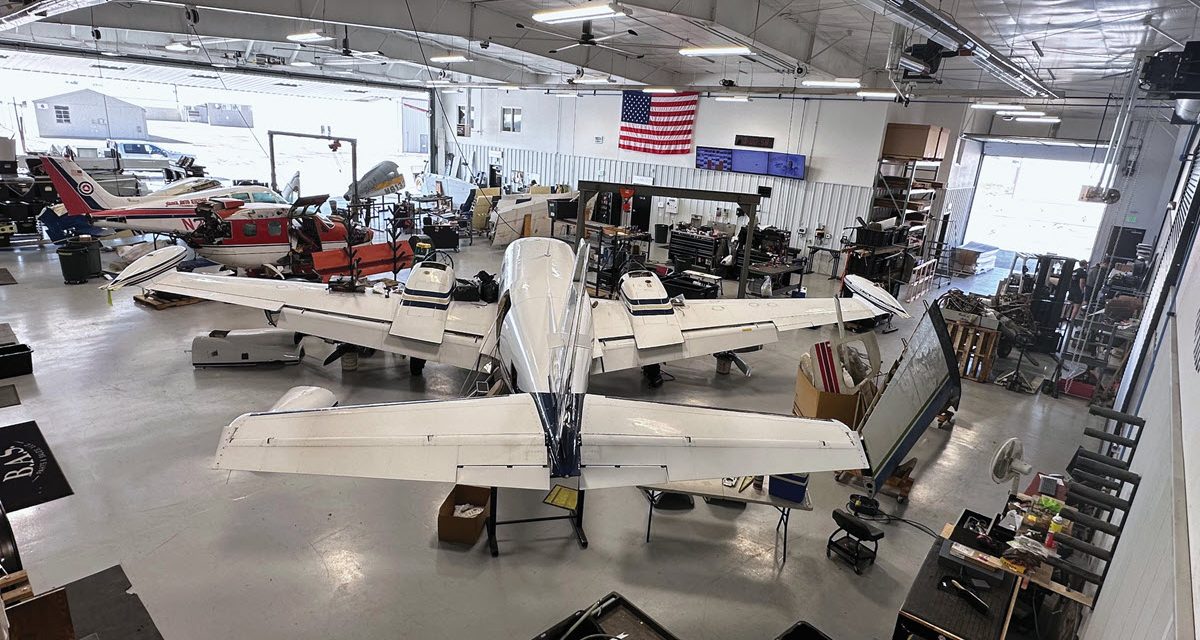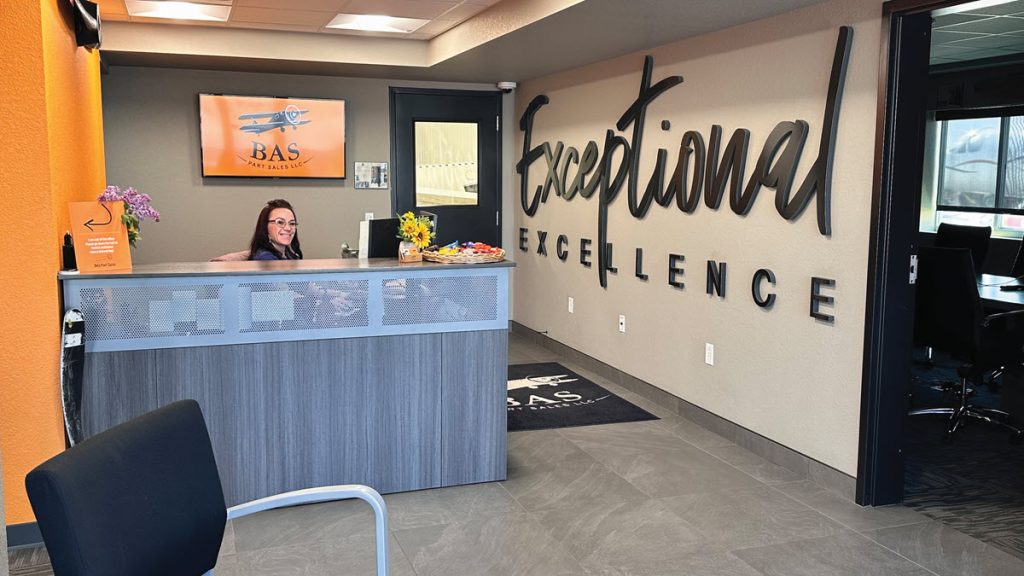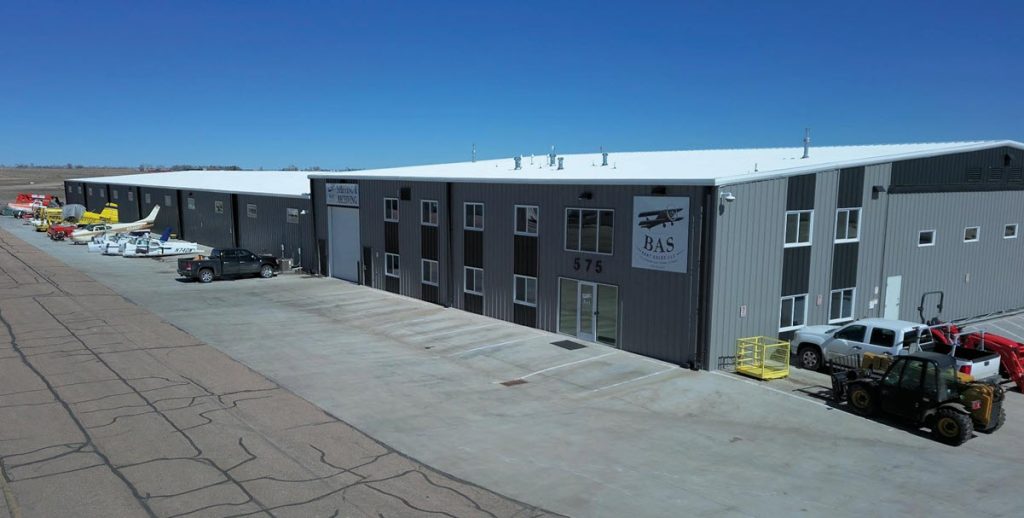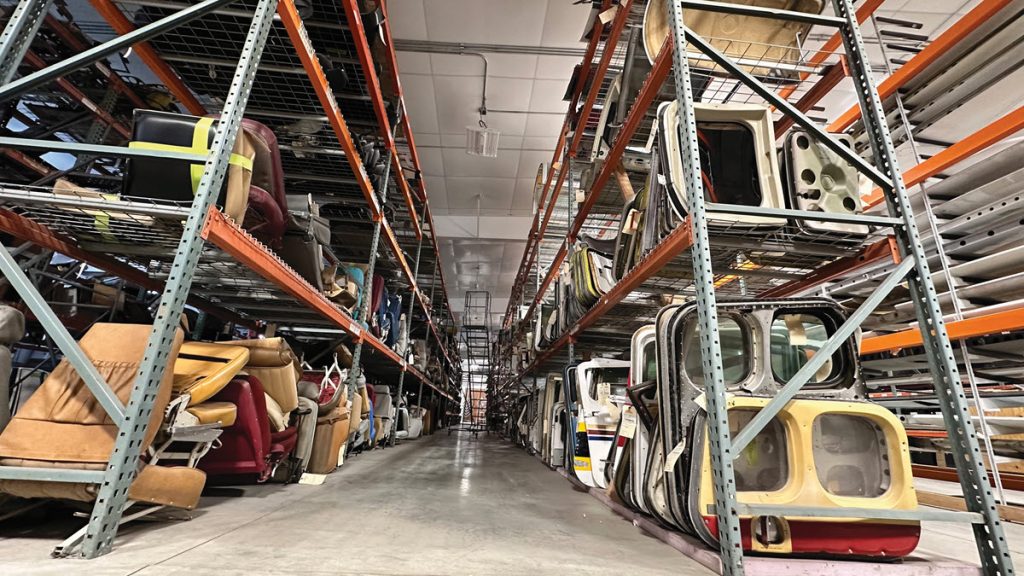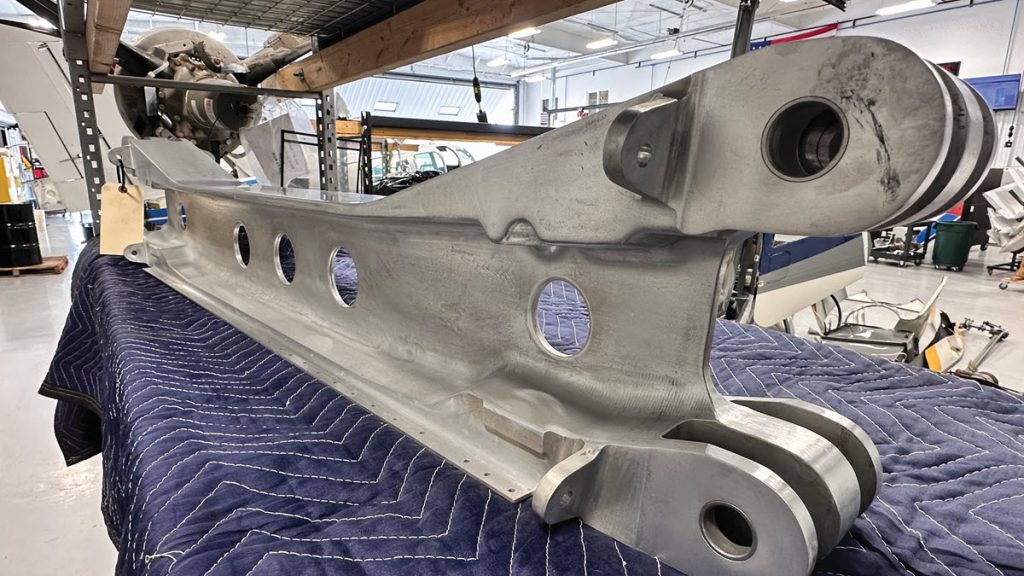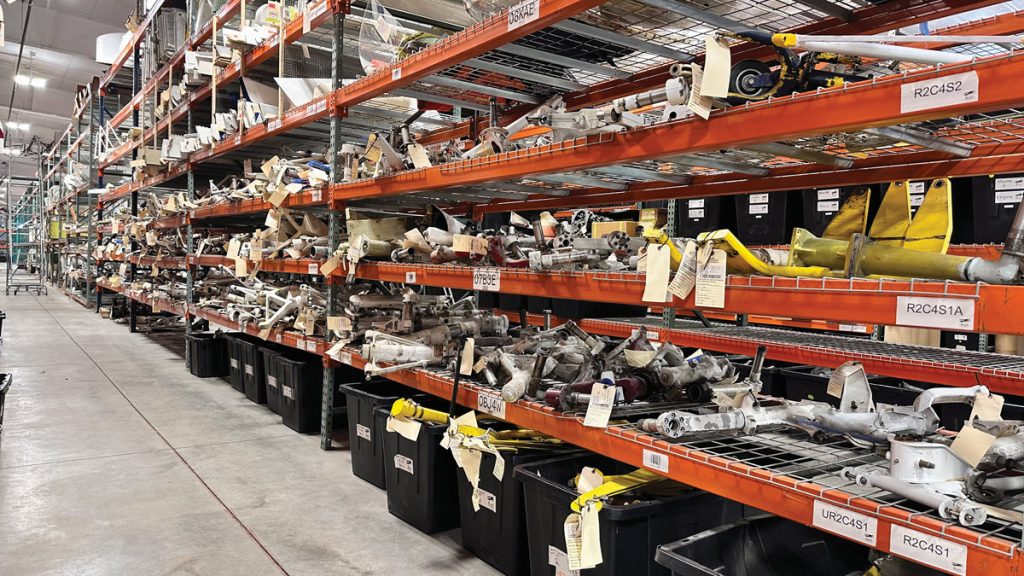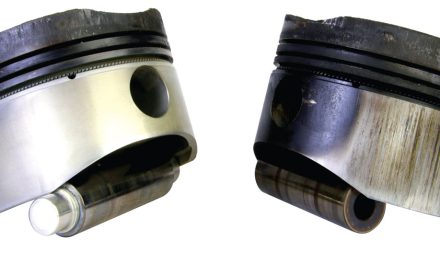By Stephanie Finnegan
As marketing director for BAS Parts Sales, Clinton McJenkin has made it his mission to change the stigma associated with the word “salvage,” which some associate with rusting piles of neglected parts in a junkyard. It’s a pet peeve of his that so many pilots and plane owners are under the impression that salvage parts are inferior quality.
To overcome this misconception, Clinton has leveraged social media to inform and instruct potential customers. “We utilize social media, the internet, the mobile app universe to promote and showcase the concept that ‘salvage’ doesn’t equate to ‘junkyard,’ and by utilizing our salvage business, you can spend more time in the air while spending less money. We publish a blog series, New in the Hangar, showcasing the aircraft being brought into the disassembly hangar. We do a write-up, post pictures, produce a walk-around video, etc., for each of the aircraft in the group. We publish that on our blog, promote it on social media, and push notifications through our mobile app.”
BAS Parts Sales is an 11-year-old company with an enviable presence in both the brick-and-mortar world of inventory and the ever-expanding platform of online and social media commerce. Like many businesses have learned in the past decade, potential customers can live anywhere in the world, and their need for a product can occur at any time. That means providing a website that provides needed information, sales fulfillment, and reliable service.
Miles and Miles of Parts and Components
BAS is headquartered in Greeley, Colorado, in a 48,000-square-foot hangar located at the Greeley Airport, and the company is currently preparing to move into a second hangar at the airport. Additionally, BAS acquired White Industries in Bates City, Missouri, and has rebranded that as BAS Kansas City (BAS KC). The KC location is comprised of 160 acres of airfield with roughly 2,000 aircraft sitting in the field and around 90,000 square feet of hangar space with parts storage.
When BAS acquired White, they did more than just take over a site and its merchandise. BAS surveyed the physical layout and business-cultural “lay of the land” and began an all-encompassing update of how things needed to get done.
“The moment we closed the acquisition, we launched into upgrading facilities and equipment and increasing the staffing to duplicate the processes we developed in Colorado. At the same time, we are trucking airplanes and truckloads of parts back to Greeley to run those through our operation to get that merchandise online and available to our customers as quickly as possible,” Clinton said.
One of the fears about purchasing a part from a salvage business is the anxiety that an item is forgotten about, not valued, and therefore is corroded and in disrepair. To Clinton’s way of thinking, that is an improbable scenario. It flies in the face of everything he knows about the salvage methodology at BAS.
“In the Greeley operation, we surgically disassemble each and every aircraft we acquire, down to the paint. We put completely stripped fuselages in our outdoor storage yard, which is about five acres. The parts go through an extensive cleaning, research, tagging, and listing process before making them available for sale on our e-commerce website and mobile app. We put every item online with pictures, prices, data, and details — which is not normal in the used airplane parts business,” Clinton observed. In his estimation, a well-run salvage business goes beyond just simply selling parts. It means carefully reviewing, refining, and re-invigorating their inventory, and enthusiastically standing behind their products.
Secondhand Means an Extended Second Life
The hot topic over the last five years is the launching of the “green economy.” Its mantra is “reuse, recycle, and repurpose.” By its very nature, the salvage industry helps to achieve these goals. For customers who are concerned about conservation and being good stewards of the earth, the salvage model decreases the number of parts that would have ended up buried in landfills. Likewise, it reduces the amount of pollution that would have been created when brand-new parts are manufactured, plus it cuts down the need for sourcing raw materials.
Beyond the environmental benefits, the salvage alternative saves planes from being permanently grounded because they’re no longer airworthy. Clinton pointed out that BAS “has inventory that keeps aircraft from the 1950s, 1960s, and 1970s, etc., in the air today. We have inventory on our shelves, ready to ship, for aircraft going back to the 1940s.” The access to these antique and vintage parts is a godsend for many plane owners, and it is why older planes are able to remain flying.
“Daily, we provide parts for airplane owners who would otherwise be in a tough spot. Selling an airplane that won’t certify to fly because you can’t find or afford the parts is not appealing, especially compared to the cost of buying a more modern aircraft. By furnishing parts for those decades-old makes and models, we help pilots stay in the air for years to come. Flying is a passion for many people. We help them continue to afford to enjoy their passion. And we often help them continue to enjoy flying that specific aircraft that they love so much,” Clinton said.
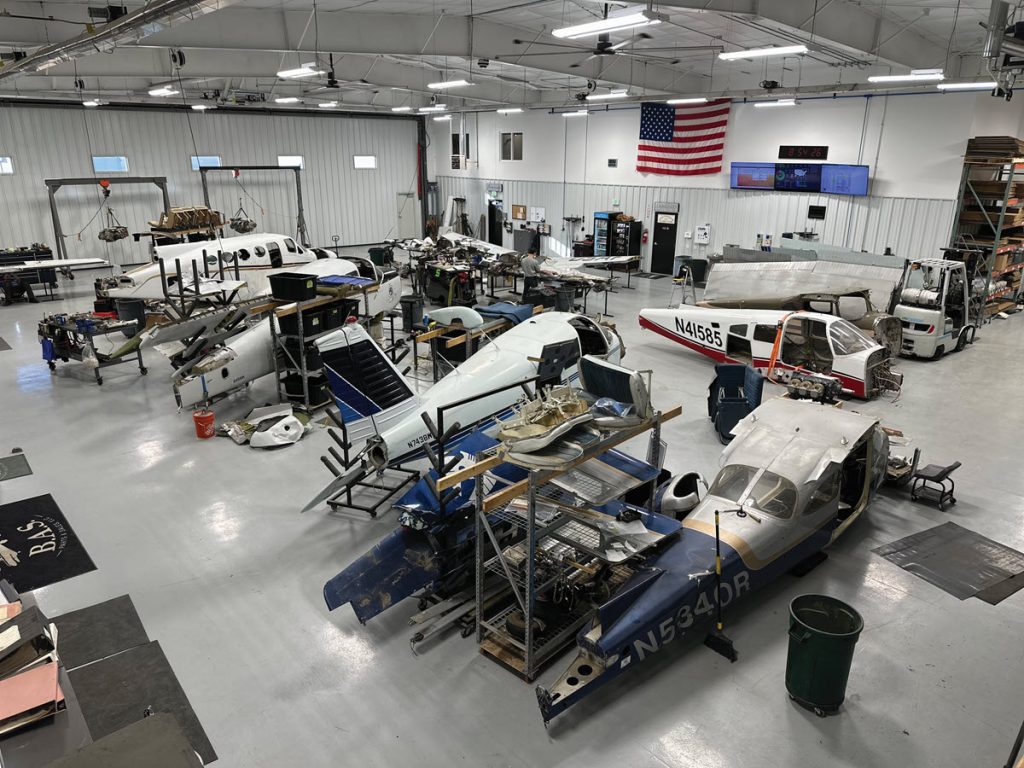
Keeping an Eye on the Expiration Date
When many shoppers arrive at the milk cooler in the supermarket, rather than grabbing the first jug of milk, they might spend a little extra time rooting around the freezer section until they find one with the longest sell-by date. No one wants to go home with a half-gallon of milk that may go sour within a few days. The same principle applies to a salvaged part subject to a time limit, such as a rubber hose, that potentially could become unairworthy while sitting on a shelf in a hangar somewhere. That has much greater ramifications than a jug of milk that’s gone bad.
But BAS takes those time limits into account. The company typically will not purchase planes that don’t have logbooks. This gives a layer of security and confidence to their consumers: “Logbooks are important. Traceability is a big deal on the parts we sell. We have A&Ps on staff who can dissect the logbooks and pass that info along to the end user. We tend not to be very interested in anything that we can’t verify the history and traceability on.”
The BAS team looks out for the peace of mind and physical safety of their clients. They understand the importance of maintaining inventory that is — to borrow the milk analogy — still fresh on their shelves.
“Since we buy airplanes with logs, we have a lot of this information on hand when we part out the aircraft. That info is detailed on the data tag for every part in our warehouse, which a customer can see in the image carousel for every item listed for sale on our website. If something is close to its end, we recycle it, and it never gets listed for sale. Something such as a rubber hose — our systems have a threshold for this that will send a part to recycling if it’s out of alignment with our standards,” Clinton explained. “We inspect for damage and test the parts we can test, but we don’t certify for airworthiness. That is done by the installation mechanic, and this is part of the reason we offer such a great return policy. We send some key components out for 8130, but do not certify in-house.”
A Wide Ranges of Part Sources
Clinton estimates that about 70% of BAS’s planes come through the insurance process. “The other 30% come from individuals in a wide range of scenarios. We buy parts from shops and repair stations. We buy half-completed projects that people get tired of working on; those usually come with lots of parts. We have bought several competitors this year — White Industries and the salvage side of Lasars, to name just two,” Clinton stated.
“If the aircraft was wrecked and the insurance company totaled it, we will make a bid on the salvage so we can disassemble it into parts. This is a very common source of airplanes for us. But we also get inquiries daily from people wanting to sell for a wide range of reasons. Maybe because the cost of the annual and repairs exceeds the value of the aircraft, or weather damaged the aircraft, and the repairs are too expensive. We buy from pilots who are aging out of their hobby and need to sell the airplane. Neglect, leaky hangars, corrosion, weather, beyond economical repair, sheer cost of maintenance, and annuals are all fairly common causes that will send an airplane through our processes.”
The variety of parts, and the reasons for popping up in the salvage hangar, are as diverse as who buys from a salvage company. Who buys salvaged components? The answer is quite simple: everyone.
“We sell to as many individuals as we do to shops and repair stations. We sell to companies that refurbish, overhaul, and certify parts. We sell to artists, collectors, and aviation enthusiasts. We have a massive client list of aviation schools and training centers around the world that buy from us to train the next generation of mechanics, engineers, pilots, etc. The common denominator among all our customers as to why they choose to buy from us comes down to price, availability, and our unrivaled customer service,” Clinton noted.
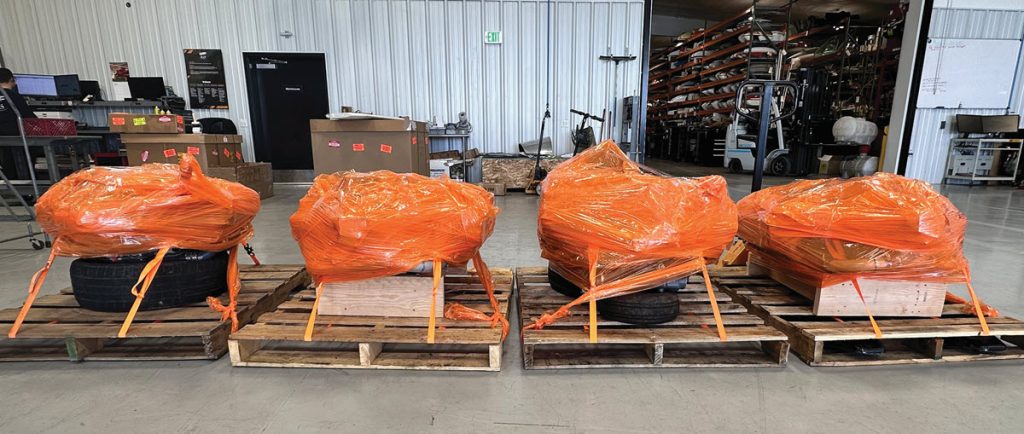
Cyberspace to the Rescue
The aviation world is a tight-knit community of shared passion, so it makes sense that a salvage parts business would seek to meet the needs of customers around the globe. It is a small world, indeed, when shopping and browsing can be done online.
“Our customers are anywhere and everywhere in the world. On average, we sell to four or five unique countries on any given day. In 2022, we sold to over 60 countries,” Clinton remarked.
The customers gravitate to the website because this salvage company has tens of thousands of parts available — and even into the millions in the Missouri branch: “Our website has roughly 60,000 items listed, with thousands of those being more than one unit in stock. We estimate that BAS Kansas City has several million items available, not counting what is still bolted onto aircraft in the field.
Daily, the salvage team receives and handles newly arrived pieces and ensures that every part goes through an exacting and thorough inspection and inventorying.
“We are buying aircraft every single day. Our shop disassembles hundreds of aircraft throughout the year. So, our machine is always churning out more inventory, and those items are getting listed daily. This means that our website and our mobile app are in constant motion every day, with items selling and items being added by our listing team.”

The What and Why of Availability
Aviation salvage companies are a great option for plane owners who want convenience, excellent part availability, and a great price compared to brand-new parts.
“It is hard to narrow down to a category of parts that we sell most often because we sell so much for many different needs, and that merchandise runs the full spectrum of aviation parts from nuts and bolts to indicators and instruments to wings and fuselages, and every part number in the middle. It spreads across needs from maintenance, annual inspections, equipment failures, etc., to a pilot’s wants and desires,” Clinton detailed. “Needs from component failures or routine maintenance seem to be the most common need that drives our sales.”
Landing gear has proven to be a hot commodity at BAS — from forks and actuators to nuts and bolts to whole landing gear assemblies. Surfaces are also in high demand: “When someone’s aircraft is caught in a hailstorm, for example, repairing a damaged wing, horizontal, or aileron, etc., can be quite cost-effective and quick when using BAS Part Sales.”
Customers also seek out salvaged parts when they’re undertaking a renovation and upgrade. “We have a Piper M600 in the shop as salvage; it’s in the process of being disassembled. The interior was sold to someone with an older PA-46 model who wanted that highly upgraded M600 leather interior. So, he made an investment in his PA-46 that was much, much less than making the same upgrade through other means,” Clinton said. “Avionics works like this, too. We can’t keep current Garmin avionics on the shelf. They don’t sit in our store for more than a few days. Upgrades with significant cost savings are a big sales driver.” A pilot can spend thousands less upgrading to the latest Garmin avionics through a salvage provider than by buying new equipment.
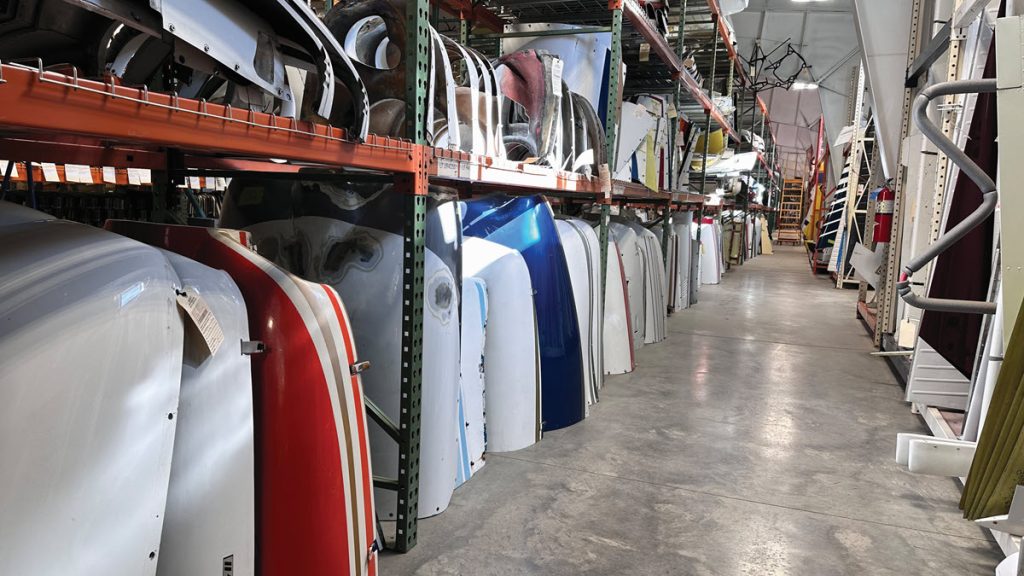
One Size Doesn’t Fit All
As an owner of an older plane or a hand-built craft, there are, of course, concerns that a salvaged part may not be the exact, required fit. Is that a legitimate worry or can that fear be dismissed? Do salvage businesses address the fact that a rivet hole might not line up from one doorframe to the next?
“Generally speaking, this kind of problem is something that the A&P is trained to deal with. Most of the time, the A&P installing the part can make the part work by back-drilling rivet holes, legally oversizing rivets, etc. The mechanic has a range of tools and resources for dealing with this problem. In the instances where a part simply won’t work, we can make it right by providing our 90-day money-back guarantee,” Clinton said.
Because it’s possible that a part won’t fit, BAS has a protocol for that situation. “We don’t remove Piper fuel tanks for the wing for exactly this reason. Making the fuel tanks line up from one wing to another is difficult. So, we leave the tanks attached and sell them with the wing,” Clinton explained. “We also spend a ton of time in the parts manuals for each and every aircraft we buy. Our team can tear down a plane and label parts with accurate part numbers down to the smallest of the nuts and bolts. So, when we sell something, it is very part number driven. We might ask for the tail and serial number to hunt down the exact part number you need to fix your door, let’s say. And then we’ll search our inventory for that part number. We know how to do this very well. Our team does it quickly, thanks to the implementation of technology, while you are still on the phone.”
This salvage company also goes beyond what is expected in common courtesy; they have a policy of making referrals to a competitor’s inventory if a requested part is not in their database: “We operate on a seriously elevated level of customer service that we think puts us leaps and bounds ahead of any competitor. If you call us and we don’t have it, we will do a quick search, tell you if a competitor does, and provide you with their phone number. We do this all the time.” Think Pepsi putting in a good word about Coke— it ordinarily doesn’t happen.
“Furthermore, a customer can send us pictures via email, through our mobile app, chat on our website, or through Facebook Messenger, and we will use those pictures and the airplane info to be as accurate as possible. Hand-built just takes more time and detail. We have to trade more info between us to make sure we have something that will fit.”
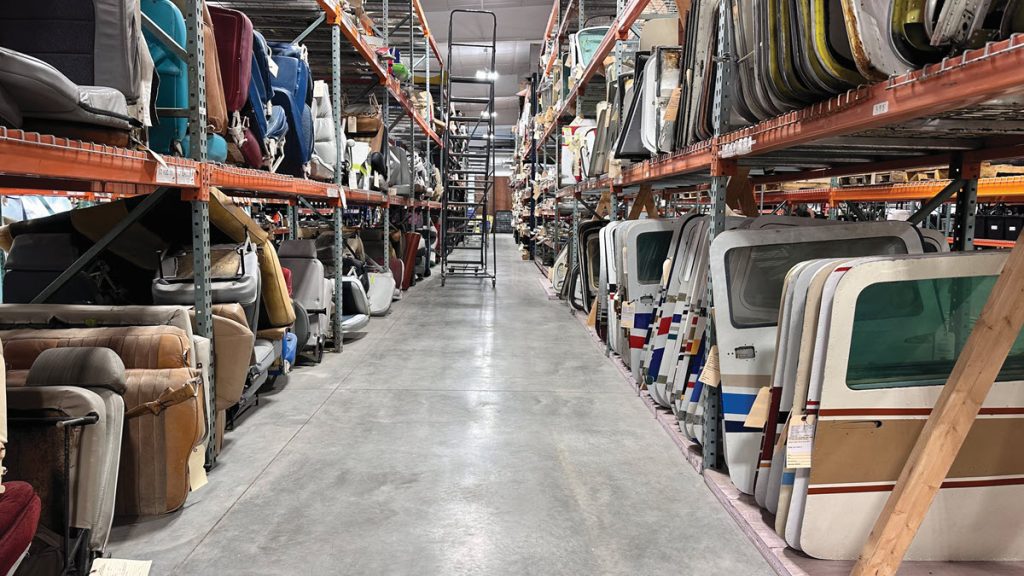
Right to Your Doorstep
Since the backbone of the salvage business is supplying customers with hard-to-find parts, the companies have to make certain that these components are easy to receive. It does no one any good if a part is ordered and then months pass by as the client impatiently awaits its arrival.
“We can safely move any part — whether large or small — to any destination worldwide. On our shipping page, you see a large fabric wing going into its crate. That wing had to travel by truck, by sea, and then again by truck to reach its destination in rural Alaska. It arrived in the same condition it left, certified quickly, and the pilot was back in the air quickly, thanks to our expertise at shipping items such as this. This wing is a good example of how we handle large items such as engines, ailerons, and surfaces, etc.,” Clinton mentioned.
Once again demonstrating the importance of customer care and protecting and preserving parts, the BAS team tackles the shipping requirements with laser-focused precision. “We build custom crates for all sorts of things. Really, anything that won’t go in a UPS box is going to get crated, or we will build a box around it so that it travels safely. We have a machine in the shipping department that allows us to make custom foam around an item. We use that machine daily to create custom packaging so that a sensitive part gets where it needs to go without damage.”
A One-Stop Parts Shop Geared for Customer Satisfaction
Through customer-friendly prices, ever-expanding inventory, and learning what works and what doesn’t in an online setting, BAS and the salvage industry as a whole are slated for a bigger, better, and brighter future: “You will see used airplane parts become more and more common as the cost of new ones go higher and higher, and the cost of a newer airplane continues to soar. We are more relevant and important to the industry than ever before. And we are well appointed to make it easier and safer to buy used airplane parts than it has ever been. This is the legacy that BAS is building, and it is important to the aviation industry in so many ways.”
For more information, visit baspartsales.com or call (970) 313-4823 or (970) 616-0941.

